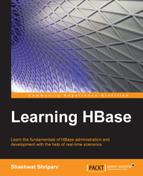This book will provide a top-down approach to learning HBase, which will be useful for both novices and experts. You will start learning configuration, code to maintenance, and troubleshooting—a kind of all-in-one HBase knowledge bank. This will be a step-by-step guide, which will help you work on HBase. The book will include day-to-day activities using HBase administration, and the implementation of Hadoop, plus HBase cluster setup from ground approach. The book will cover a complete list of use cases and explanations to implement HBase as an effective Big Data tool. It will also help you understand the layout and structure of HBase. There are lots of books available on the market on HBase, but they lack something in them; some of them focuses more on configuration and some on coding, but this book will provide a kind of start-to-end approach, which will be useful for a person with zero knowledge in HBase to the person proficient in HBase. This book is a complete guide to HBase administration and development with real-time scenarios and an operation guide.
This book will provide an understanding of what HBase is like, where it came from, who all are involved, why should we consider using it, why people are using it, when to use it, and how to use it. This book will give overall information about the HBase ecosystem. It's more like an HBase-confusion-buster book, a book to read and implement in real life. The book has in-depth theory and practical examples on HBase features. This theoretical and practical approach clears doubts on Hadoop and HBase. It provides complete guidance on configuration/management/troubleshooting of HBase clusters and their operations. The book is targeted at administration and development aspects of HBase; administration with troubleshooting, setup, and development with client and server APIs. This book also enables you to design schema, code in Java, and write shell scripts to work with HBase.
Chapter 1, Understanding the HBase Ecosystem, introduces HBase in detail, and discusses its features, its evolution, and its architecture. We will compare HBase with traditional databases and look at add-on features and the various underlying components, and its uses in the industry.
Chapter 2, Let's Begin with HBase, deals with the HBase components in detail, their internal architecture, communication between different components, how it provides scalability, as well as the HBase reading and writing cycle process, HBase housekeeping tasks, region-related operations, the different components needed for a HBase cluster configuration, and some basic OS tuning.
Chapter 3, Let's Start Building It, lets us proceed ahead with building an HBase cluster. In this chapter, you will find information on the various components and the places we can get it from. We will start configuring the cluster and consider all the parameters and optimization tweaks while building the Hadoop and HBase cluster. One section in the chapter will focus on the various component-level and OS-level parameters for an optimized cluster.
Chapter 4, Optimizing the HBase/Hadoop Cluster, teaches us to optimize the HBase cluster according to the production environment and running cluster troubleshooting tasks. We will look at optimization on hardware, OS, software, and network parameters. This chapter will also teach us how we can optimize Hadoop for a better HBase.
Chapter 5, The Storage, Structure Layout, and Data Model of HBase, discusses HBase's data model and its various data model operations for fetching and writing data in HBase tables. We will also consider some use cases in order to design schema in HBase.
Chapter 6, HBase Cluster Maintenance and Troubleshooting, covers all the aspects of HBase cluster management, operation, and maintenance. Once a cluster is built and in operation, we need to look after it, continuously tune it up, and troubleshoot in order to have a healthy HBase cluster. We will also study the commands available with HBase and Hadoop shell.
Chapter 7, Scripting in HBase, explains an automation process using HBase and shell scripts. We will learn to write scripts as an administrator or developer to automate various data-model-related tasks. We will also read about various backup and restore options available in HBase and how to perform them.
Chapter 8, Coding HBase in Java, teaches Java coding in HBase. We will start with basic Java coding in HBase and learn about Java APIs available for client requests. You will also learn to build a basic client in Java, which can be used to contact an HBase cluster for various operations using Java code.
Chapter 9, Advance Coding in Java for HBase, focuses more on Java coding in HBase. It is a more detailed learning about all the different kind of APIs, classes, methods, and interfaces available in Java for HBase. You will also see the different kind of web services or thrift services, which you can use to ease up the coding and using the inbuilt service and not implementing the entire architecture code in Java. This chapter has a section that includes a discussion of some special features of HBase and some open source projects available, which can be used in coordination with HBase for a production cluster and a project.
Chapter 10, HBase Use Cases, discusses the use cases in the industry, which are being used with HBase as their underlying technology.
